The Effect of Void Arrangement on the Pattern Transformation of Porous Soft Solids under Biaxial Loading
Abstract
:1. Introduction
2. Experiment and Numerical Simulation
2.1. Experimental Method
2.2. Preparation of Porous Samples of Silicone Rubber
- Specimen 1, comprising a microstructure of a oblique array of circular voids. All the voids have identical size with diameter 5.8 mm. They are arranged with 6.6 mm center-to-center spacing vertically and horizontally.
- Specimens 2–4, comprising a microstructure of a , , square arrays of circular voids. All the voids have identical size with diameter 5.8 mm. They are arranged with 6.6 mm center-to-center spacing vertically and horizontally.
2.3. Material Models for Silicone Rubber
2.4. Buckling and Post-Buckling Analysis
3. Results and Discussion
4. Conclusions
- The different pattern transformations (e.g., alternating orthogonal ellipses PT I and chevron pattern PT II) of the porous soft solids with square lattices of voids can be controlled quantitatively by adjusting number of voids and biaxiality ratios through experiments and simulations. This discovery provides a new way to design the void morphologies of soft solids for controlling their deformation patterns under a specific biaxial stress-state.
- A new type of specimen with oblique lattices of circular voids was designed. In the experiment, a new pattern transformation (the elliptic voids were not orthogonal but with an inclined angle PT III) was observed that has rarely been reported in previous studies. This discovery offers new opportunities for fabricating tunable apparatuses and imprinting complex patterns of soft materials.
Author Contributions
Funding
Institutional Review Board Statement
Informed Consent Statement
Data Availability Statement
Acknowledgments
Conflicts of Interest
References
- Gibson, L.J.; Ashby, M.F. Cellular Solids: Structure and Properties; Cambridge University Press: Cambridge, UK, 1997. [Google Scholar]
- Lee, J.H.; Singer, J.P.; Thomas, E.L. Micro-/Nanostructured Mechanical Metamaterials. Adv. Mater. 2012, 24, 4782–4810. [Google Scholar] [CrossRef] [PubMed]
- Grima, J.N.; Caruana-Gauci, R. Mechanical metamaterials: Materials that push back. Nat. Mater. 2012, 11, 565–566. [Google Scholar] [CrossRef] [PubMed]
- Zheng, X.; Lee, H.; Weisgraber, T.H. Ultralight, Ultrastiff Mechanical Metamaterials. Science 2014, 344, 1373–1377. [Google Scholar] [CrossRef] [Green Version]
- Zadpoor, A.A. Mechanical meta-materials. Mater. Horizons 2016, 3, 371–381. [Google Scholar] [CrossRef] [Green Version]
- Fleck, N.; Deshpande, V.; Ashby, M. Micro-architectured materials: Past, present and future. Proc. Math. Phys. Eng. Sci. 2010, 466, 2495–2516. [Google Scholar] [CrossRef]
- Ashby, M. Designing architectured materials. Scr. Mater. 2013, 68, 4–7. [Google Scholar] [CrossRef]
- Barthelat, F. Architectured materials in engineering and biology: Fabrication, structure, mechanics and performance. Int. Mater. Rev. 2015, 60, 413–430. [Google Scholar] [CrossRef]
- Papka, S.; Kyriakides, S. In-plane crushing of a polycarbonate honeycomb. Int. J. Solids Struct. 1998, 35, 239–267. [Google Scholar] [CrossRef]
- Papka, S.; Kyriakides, S. In-plane biaxial crushing of honeycombs. Part I: Experiments. Int. J. Solids Struct. 1999, 36, 4367–4396. [Google Scholar] [CrossRef]
- Papka, S.; Kyriakides, S. In-plane biaxial crushing of honeycombs. Part II: Analysis. Int. J. Solids Struct. 1999, 36, 4397–4423. [Google Scholar] [CrossRef]
- Gong, L.; Kyriakides, S.; Jang, W. Compressive response of open-cell foams. Part I: Morphology and elastic properties. Int. J. Solids Struct. 2005, 42, 1355–1379. [Google Scholar] [CrossRef]
- Gong, L.; Kyriakides, S.; Jang, W. Compressive response of open-cell foams. Part II: Initiation and evolution of crushing. Int. J. Solids Struct. 2005, 42, 1381–1399. [Google Scholar] [CrossRef]
- Gong, L.; Kyriakides, S.; Triantafyllidis, N. On the stability of kelvin cell foams under compressive loads. J. Mech. Phys. Solids 2005, 53, 771–794. [Google Scholar] [CrossRef]
- Langrand, B.; Casadei, F.; Marcadon, V.; Portemont, G.; Kruch, S. Experimental and finite element analysis of cellular materials under large compaction levels. Int. J. Solids Struct. 2017, 128, 99–116. [Google Scholar] [CrossRef]
- Tantikom, K.; Aizawa, T.; Mukai, T. Symmetric and asymmetric deformation transition in the regularly cell-structured materials. part ii: Theoretical study. Int. J. Solids Struct. 2005, 42, 2211–2224. [Google Scholar] [CrossRef]
- Mullin, T.; Deschanel, S.; Bertoldi, K.; Boyce, M. Pattern transformation triggered by deformation. Phys. Rev. Lett. 2007, 99, 084301. [Google Scholar] [CrossRef] [PubMed] [Green Version]
- Michel, J.; Lopez Pamies, O.; Ponte Castaneda, P.; Trantafyllidis, N. Microscopic and macroscopic instabilities in finitely strained porous elastomers. J. Mech. Phys. Solids 2007, 55, 900–938. [Google Scholar] [CrossRef] [Green Version]
- Lötters, J.C.; Olthuis, W.; Veltink, P.; Bergveld, P. The mechanical properties of the rubber elastic polymer polydimethylsiloxane for sensor applications. J. Micromech. Microeng. 1997, 7, 145. [Google Scholar] [CrossRef]
- Brunet, T.; Merlin, A.; Mascaro, B.; Zimny, K.; Leng, J.; Poncelet, O.; Aristégui, C.; Mondain-Monval, O. Soft 3D acoustic metamaterial with negative index. Nat. Mater. 2015, 14, 384. [Google Scholar] [CrossRef] [PubMed]
- Qiu, H.; Li, Y.; Guo, T.F.; Guo, X.; Tang, S. Deformation and pattern transformation of porous soft solids under biaxial loading: Experiments and simulations. Extrem. Mech. Lett. 2018, 20, 81–90. [Google Scholar] [CrossRef]
- Bertoldi, K.; Reis, P.M.; Willshaw, S.; Mullin, T. Negative poisson’s ratio behavior induced by an elastic instability. Adv. Mater. 2010, 22, 361–366. [Google Scholar] [CrossRef] [Green Version]
- Babaee, S.; Shim, J.; Weaver, J.C.; Chen, E.R.; Patel, N.; Bertoldi, K. 3D soft metamaterials with negative poisson’s ratio. Adv. Mater. 2013, 25, 5044–5049. [Google Scholar] [CrossRef] [PubMed]
- Bertoldi, K.; Boyce, M.; Deschanel, S.; Prange, S.; Mullin, T. Mechanics of deformation-triggered pattern transformations and superelastic behavior in periodic elastomeric structures. J. Mech. Phys. Solids 2008, 56, 2642–2668. [Google Scholar] [CrossRef]
- Singamaneni, S.; Tsukruk, V.V. Buckling instabilities in periodic composite polymeric materials. Soft Matter 2010, 6, 5681–5692. [Google Scholar] [CrossRef]
- Singamaneni, S.; Bertoldi, K.; Chang, S.; Jang, J.H.; Young, S.; Thomas, E.; Boyce, M.; Tsukruk, V. Bifurcated mechanical behavior of deformed periodic porous solids. Adv. Funct. Mater. 2009, 19, 1426–1436. [Google Scholar] [CrossRef]
- Overvelde, J.; Shan, S.; Bertoldi, K. Compaction through buckling in 2d periodic, soft and porous structures: Effect of pore shape. Adv. Mater. 2012, 24, 2337–2342. [Google Scholar] [CrossRef] [Green Version]
- Overvelde, J.; Bertoldi, K. Relating pore shape to the non-linear response of periodic elastomeric structures. J. Mech. Phys. Solids 2014, 64, 351–366. [Google Scholar] [CrossRef]
- Li, G.Y.; Zheng, Y.; Cao, Y. Tunable defect mode in a soft wrinkled bilayer system. Extrem. Mech. Lett. 2016, 9, 171–174. [Google Scholar] [CrossRef] [Green Version]
- Lin, G.; Chandrasekaran, P.; Lv, C.; Zhang, Q.; Tang, Y.; Han, L.; Yin, J. Self-similar hierarchical wrinkles as a potential multifunctional smart window with simultaneously tunable transparency, structural color, and droplet transport. ACS Appl. Mater. Interfaces 2017, 9, 26510–26517. [Google Scholar] [CrossRef]
- Yin, J.; Yague, J.L.; Boyce, M.C.; Gleason, K.K. Biaxially mechanical tuning of 2-d reversible and irreversible surface topologies through simultaneous and sequential wrinkling. ACS Appl. Mater. Interfaces 2014, 6, 2850–28572. [Google Scholar] [CrossRef]
- Li, T.; Chen, Y.; Hu, X.; Li, Y.; Wang, L. Exploiting negative poisson’s ratio to design 3d-printed composites with enhanced mechanical properties. Mater. Des. 2018, 142, 247–258. [Google Scholar] [CrossRef]
- Chen, Y.; Li, T.; Jia, Z.; Scarpa, F.; Chun-Wei, Y.; Wang, L. 3D printed hierarchical honeycombs with shape integrity under large compressive deformations. Mater. Des. 2018, 137, 226–234. [Google Scholar] [CrossRef] [Green Version]
- Kuwabara, T.; Ikeda, S.; Kuroda, K. Measurement and analysis of differential work hardening in cold-rolled steel sheet under biaxial tension. J. Mater. Process. Technol. 1998, 80, 517–523. [Google Scholar] [CrossRef]
- Kuwabara, T.; Nakajima, T. Material modeling of 980 mpa dual phase steel sheet based on biaxial tensile test and in-plane stress reversal test. J. Solid Mech. Mater. Eng. 2011, 5, 709–720. [Google Scholar] [CrossRef] [Green Version]
- Demmerle, S.; Boehler, J. Optimal design of biaxial tensile cruciform specimens. J. Mech. Phys. Solids 1993, 41, 143–181. [Google Scholar] [CrossRef]
- Jia, Y.G.; Zhang, W.H.; Zhang, W. Optimal design and examination study of biaxial tensile specimens for solid propellant. Tuijin Jishu J. Propuls. Technol. 2011, 32, 737–740. [Google Scholar]
- Hibbitt, Karlsson & Sorensen. ABAQUS/Explicit: User’S Manual; Karlsson and Sorenson Inc.: Birmingham, AL, USA, 2001; Volume 1. [Google Scholar]
- Ogden, R.W. Non-linear elastic deformations. In Engineering Analysis with Boundary Elements; Ellis Horwood Limited.: Chichester, UK, 1984. [Google Scholar]
- Belytschko, T.; Moran, B.; Liu, W.K. Nonlinearfor Continua Finite Element Analysis and Structures; ICE Division, Zace Services Ltd.: Essex, UK, 2000. [Google Scholar]
- Javid, F.; Wang, P.; Shanian, A.; Bertoldi, K. Architected materials with ultra-low porosity for vibration control. Adv. Mater. 2016, 28, 5943–5948. [Google Scholar] [CrossRef]
- Li, Z.; Zhou, Z.; Li, Y.; Tang, S. Effect of cyclic loading on surface instability of silicone rubber under compression. Polymers 2017, 9, 148. [Google Scholar] [CrossRef] [Green Version]
- Wang, X.S.; Fan, J.H.; Wu, B.S.; Li, Y. Effects of distance and alignment holes on fatigue crack behaviors of cast magnesium alloys. Adv. Mater. Res. 2008, 33, 13–18. [Google Scholar] [CrossRef]
- Li, Y.; Qiu, X.; Yang, F.; Wang, X.S.; Yin, Y.; Fan, Q. Chirality independence in critical buckling forces of super carbon nanotubes. Solid State Commun. 2008, 148, 63–68. [Google Scholar] [CrossRef]
- Kang, S.H.; Shan, S.; Noorduin, W.L.; Khan, M.; Aizenberg, J.; Bertoldi, K. Buckling-induced reversible symmetry breaking and amplification of chirality using supported cellular structures. Adv. Mater. 2013, 25, 3380–3385. [Google Scholar] [CrossRef] [Green Version]
- Tang, S.; Greene, M.S.; Peng, X.; Liu, W.K.; Guo, Z. Chain confinement drives the mechanical properties of nanoporous polymers. Europhys. Lett. 2014, 106, 36002. [Google Scholar] [CrossRef]
- Tang, S.; Li, Y.; Liu, W.; Huang, X. Surface ripples of polymeric nanofibers under tension: The crucial role of poisson’s ratio. Macromolecules 2014, 47, 6503–6514. [Google Scholar] [CrossRef]
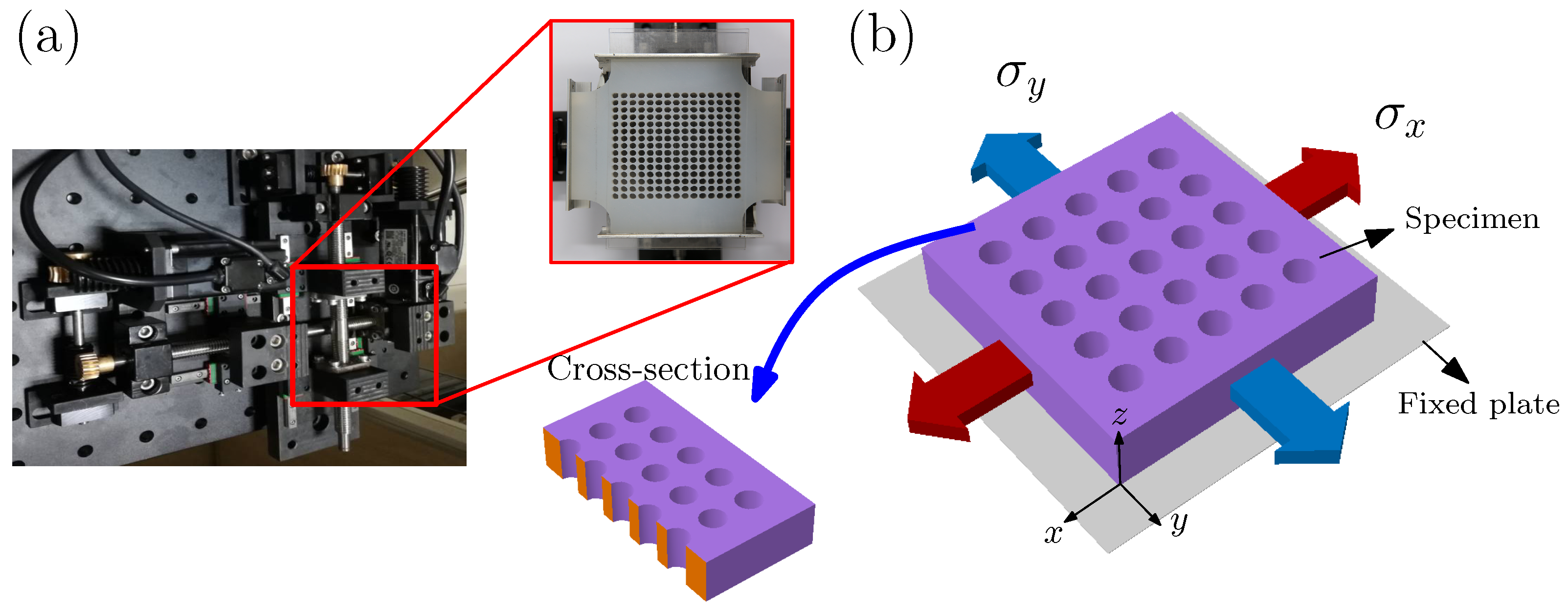

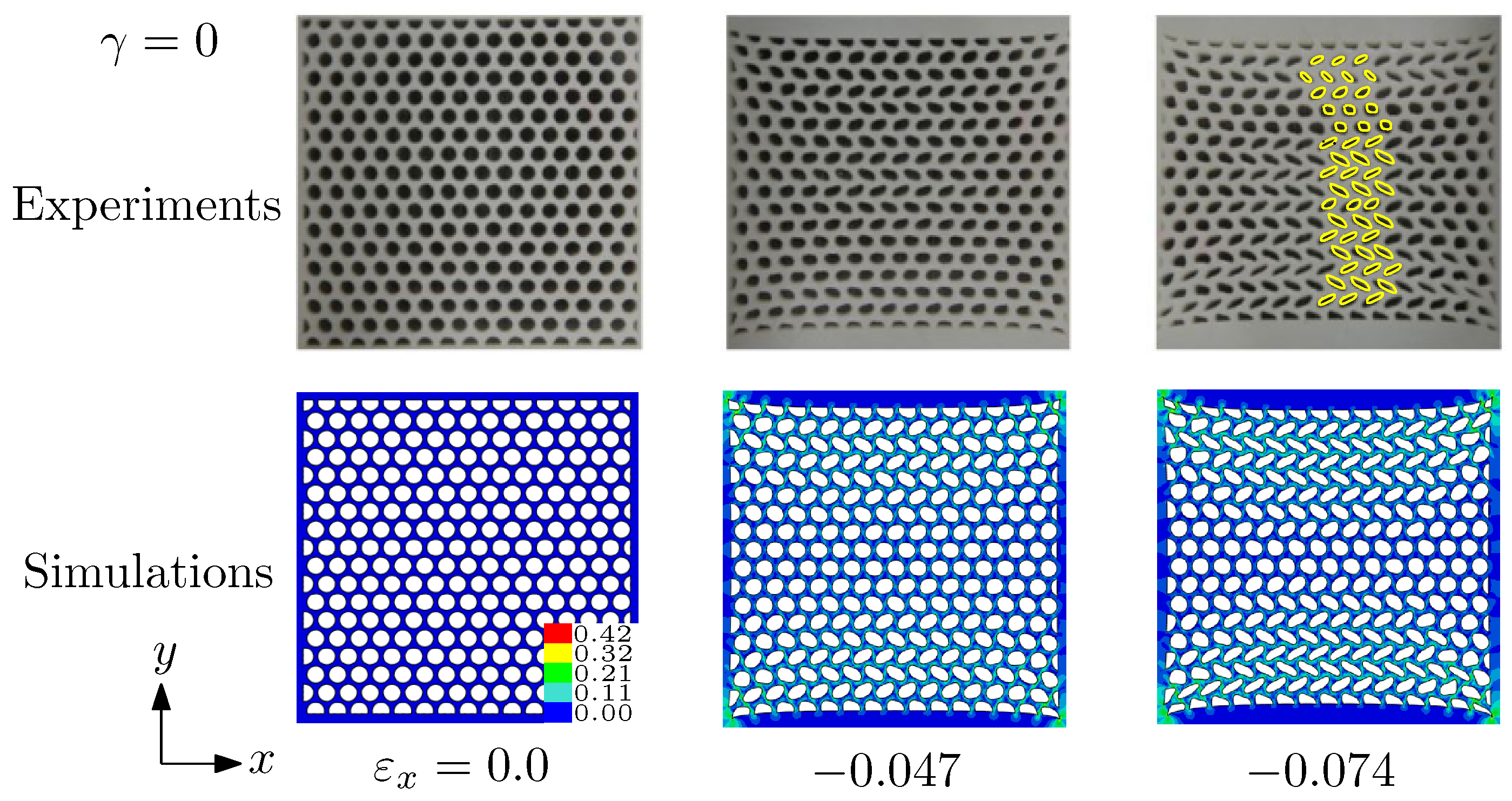


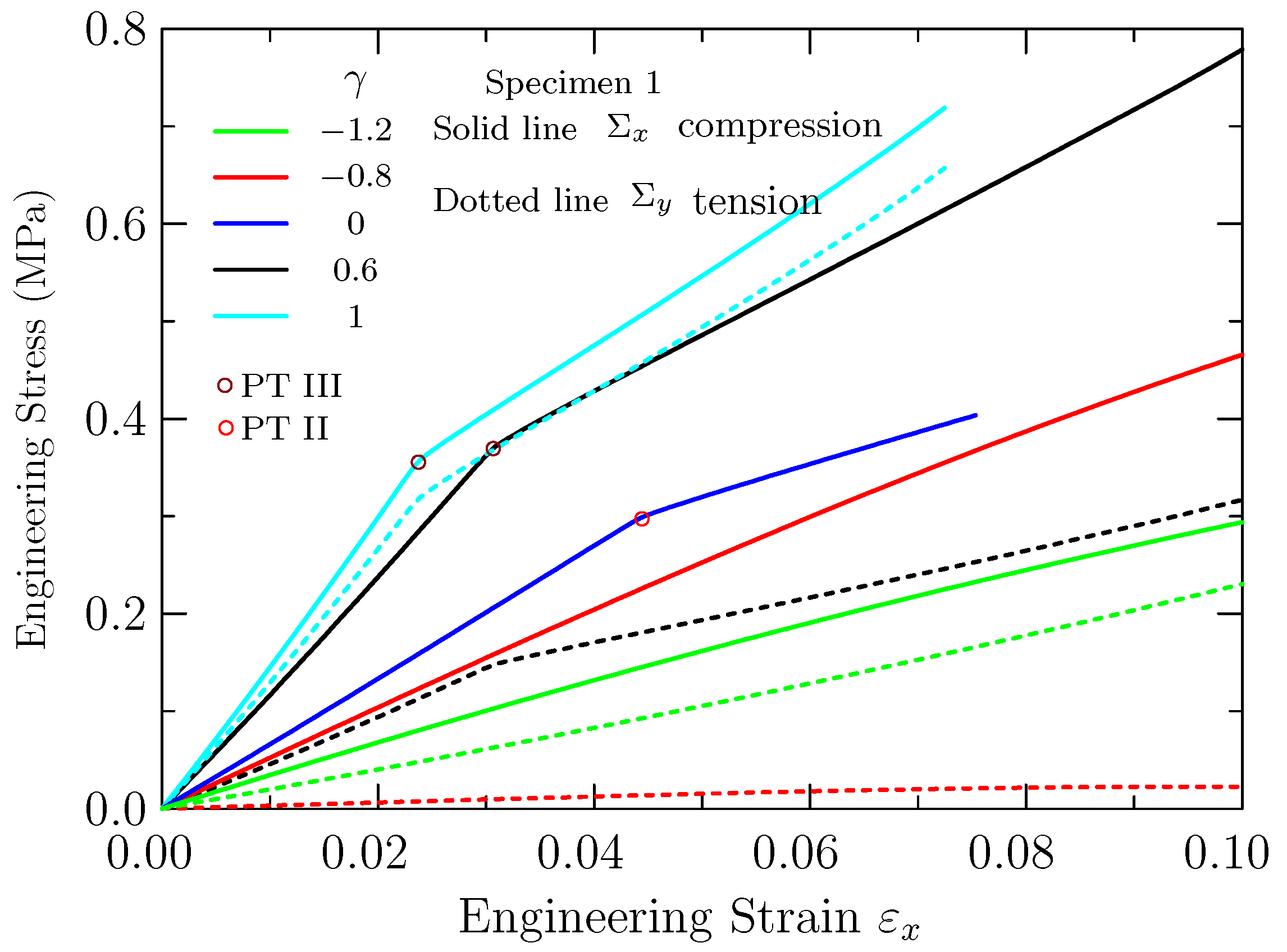

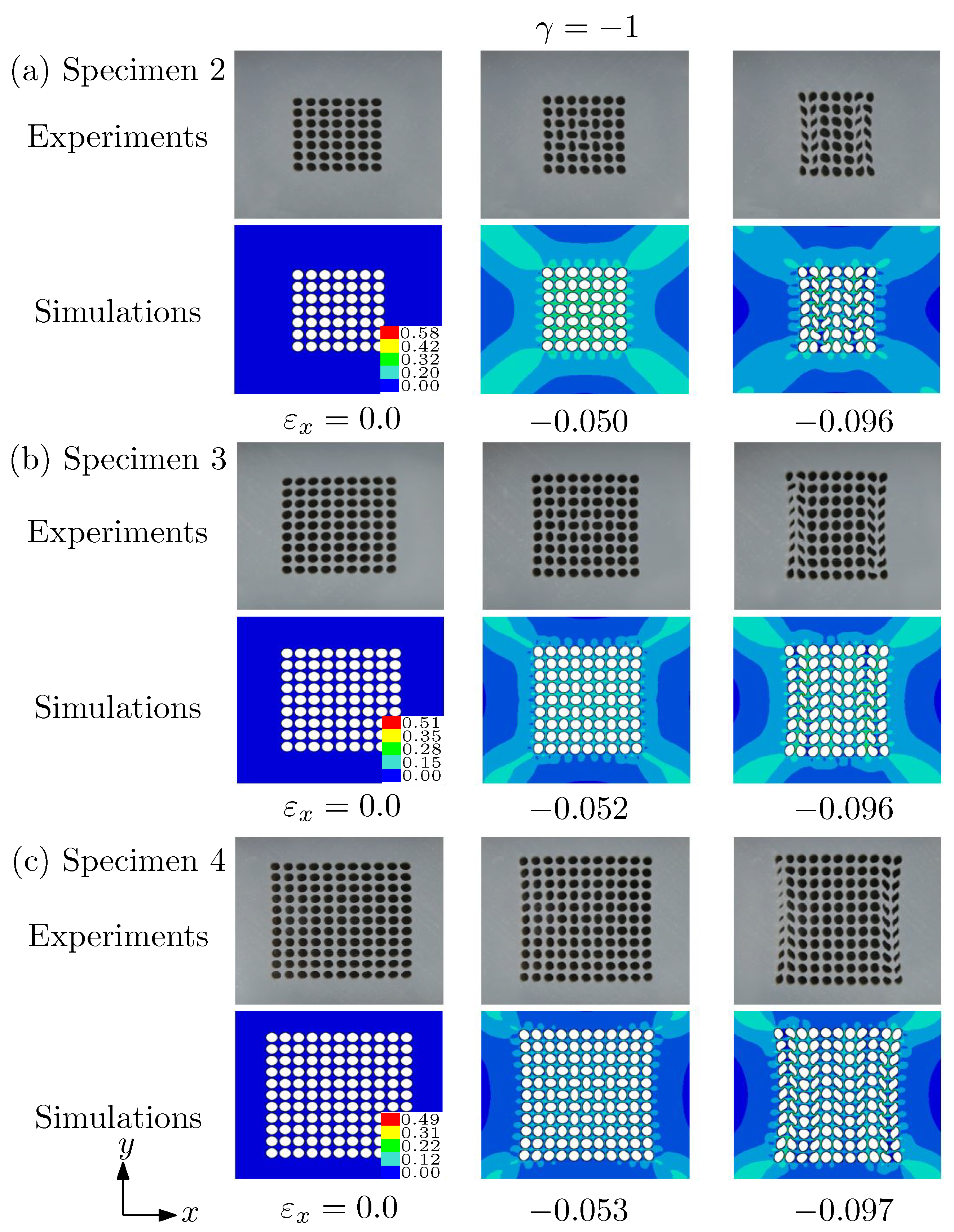
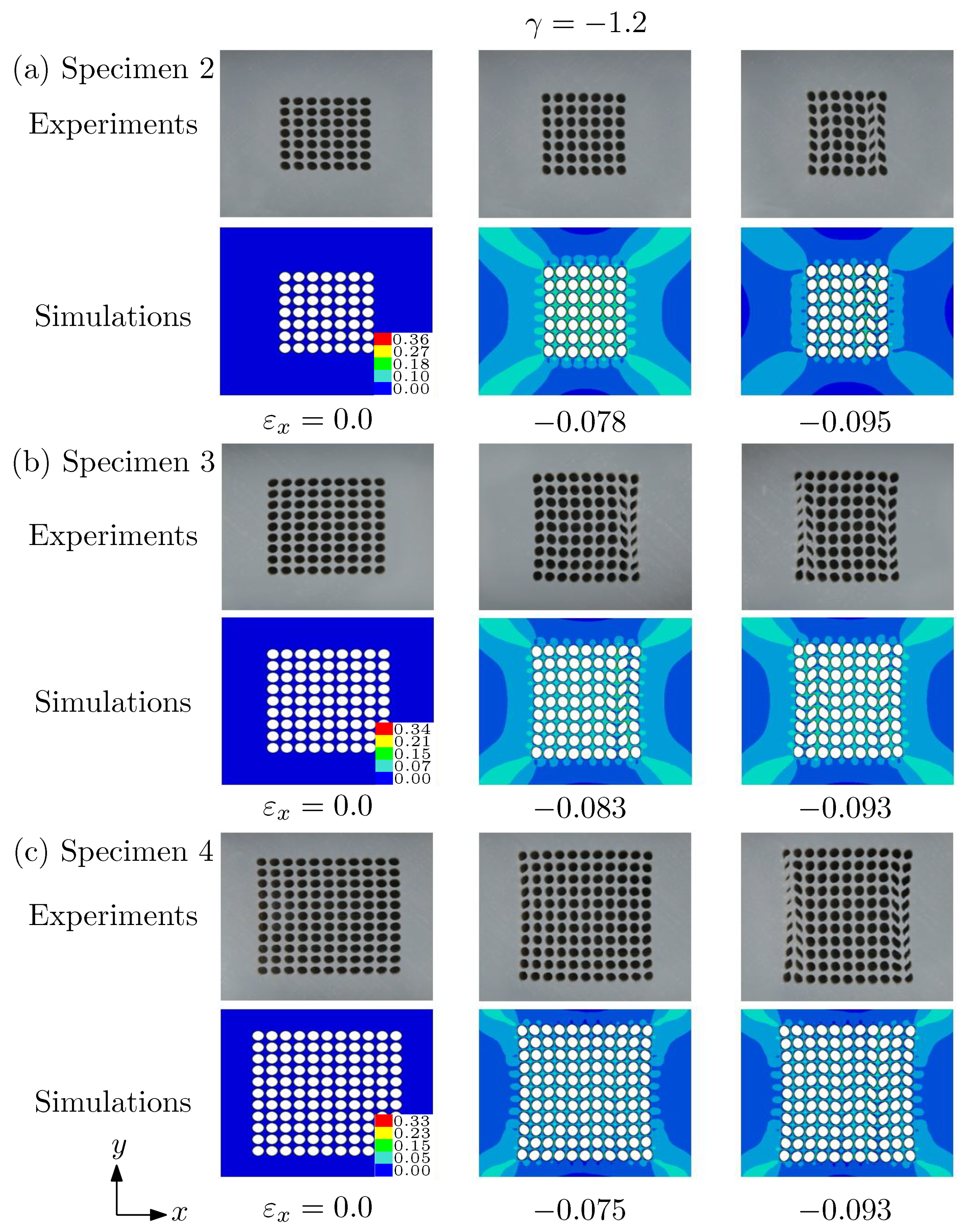

Publisher’s Note: MDPI stays neutral with regard to jurisdictional claims in published maps and institutional affiliations. |
© 2021 by the authors. Licensee MDPI, Basel, Switzerland. This article is an open access article distributed under the terms and conditions of the Creative Commons Attribution (CC BY) license (http://creativecommons.org/licenses/by/4.0/).
Share and Cite
Qiu, H.; Li, Y.; Guo, T.; Tang, S.; Xie, Z.; Guo, X. The Effect of Void Arrangement on the Pattern Transformation of Porous Soft Solids under Biaxial Loading. Materials 2021, 14, 1205. https://doi.org/10.3390/ma14051205
Qiu H, Li Y, Guo T, Tang S, Xie Z, Guo X. The Effect of Void Arrangement on the Pattern Transformation of Porous Soft Solids under Biaxial Loading. Materials. 2021; 14(5):1205. https://doi.org/10.3390/ma14051205
Chicago/Turabian StyleQiu, Hai, Ying Li, Tianfu Guo, Shan Tang, Zhaoqian Xie, and Xu Guo. 2021. "The Effect of Void Arrangement on the Pattern Transformation of Porous Soft Solids under Biaxial Loading" Materials 14, no. 5: 1205. https://doi.org/10.3390/ma14051205







